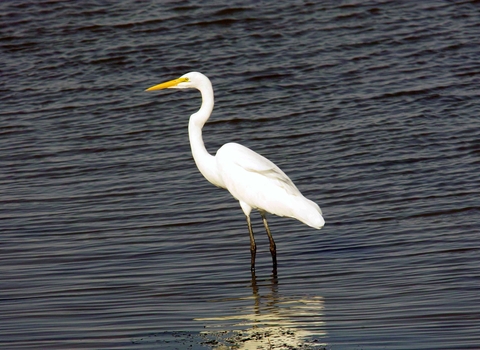
Great white egret ©Derek Moore
Great white egret
As the name suggests, this tall, white heron is considerably larger than the similar little egret. Once a rare visitor to the UK, sightings have become more common over the last few decades, with several pairs now breeding.
Scientific name
Ardea albaWhen to see
January to DecemberSpecies information
Category
Statistics
Length: 94cmWIngspan: 155cm
Weight: 870g
Classified in the UK as Amber under the Birds of Conservation Concern 5: the Red List for Birds (2021). Protected in the UK under the Wildlife and Countryside Act, 1981.
Habitats
About
Compared to the now familiar little egret, the great white egret is enormous, almost as large as a grey heron. A few decades ago, records of great white egret were less than annual, but many now winter in the UK and a few pairs even nest here. Visiting birds can be found in all kinds of wetland habitats, even farmland ditches! They stand in shallow water, waiting for fish, insects and amphibians to approach, then spear them with their dagger-like bill.How to identify
The great white egret is almost as large as a grey heron, but with longer legs and a longer neck. It has a large, dagger-like bill that is yellow for most of the year, but becomes mostly black in breeding birds. The upper legs are yellowish, sometimes turning reddish in breeding birds, and the lower legs and feet are black - unlike the yellow feet of the little egret.Distribution
Great white egrets can appear in almost any part of the UK, though they are most frequently found in south-east England and East Anglia. The Somerset Levels were home to the UK’s first breeding pair of great white egrets in 2012.Did you know?
Like the little egret, great white egrets were once persecuted for the beautiful long-white plumes of their breeding plumage, which were often used in fashion. In the United States, they were almost wiped out completely during the late 1800s.Watch
Great White Egret (https://vimeo.com/444887398)
Great White Egret by Tom Hibbert
